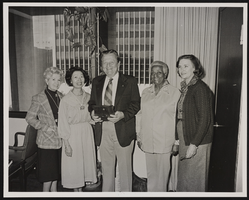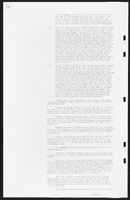Search the Special Collections and Archives Portal
Search Results

Transcript of interview with Joel Bergman by Stefani Evans and Claytee D. White, August 03, 2016
Date
Archival Collection
Description
Born in 1936, architect Joel Bergman spent his childhood in Venice, California, the son of Edythe Klein and Harry Bergman, a baker who later turned to dealing in scrap metal. The award-winning designer of such Las Vegas projects as the International Hotel, the MGM Grand Hotel (later Bally's), additions to the Riviera Hotel and the Golden Nugget downtown, the Mirage, Treasure Island, Paris Casino Resort, Caesars Palace, Trump International Hotel and Tower, the Signature at MGM Grand, Rhumbar, Gilley's at Treasure Island, and the Tropicana Hotel and Casino first arrived in Las Vegas in 1968 to work on the International Hotel. In this interview, Bergman discusses his architectural career, which began with his graduation in architecture from the University of Southern California; he also discusses his work with Martin Stern, his sixteen years with Steve Wynn, and the formation of his own architectural firm, Bergman Walls and Associates. Throughout, he pays tribute to the three mentors who had the greatest influence on his work—USC architecture professor Carleton Winslow, architect Berton Severson, and client Steve Wynn—and the ways they visualized people moving through space. He acknowledges other professionals whose work he admired and talks about his wives Marlene Federman, Terrie Colston, Maria Nicolini, and Valentina Bogdanova as well as his children and stepchildren. Joel David Bergman passed away August 24, 2016, three weeks after he gave this interview.
Text
Christine Barrett oral history interview
Identifier
Abstract
Oral history interview with Christine Barrett conducted by Claytee D. White on March 19, 2021 for African Americans in Las Vegas: a Collaborative Oral History Project.
Christine Barrett talks of her educational background and previous employment history that led her from California to Massachusetts, Virginia, and California again before her final move to Las Vegas. She has worked in management positions related to Las Vegas Valley water use for 38 years, and in the past decade has begun working for the Clark County School District in various professional capacities.
Archival Collection
U-Wah-Un Study Club Records
Identifier
Abstract
U-Wah-Un Study Club Records (1919-1987) include a complete set of the organization's yearbooks from 1919 to 1977, a club scrapbook, meeting minutes, and financial records.
Archival Collection
Pat Geuder oral history interview
Identifier
Abstract
Oral history interview with Pat Geuder conducted by Darryel Mayes on On April 15, 1980 for the Ralph Roske Oral History Project on Early Las Vegas. Geuder discusses in detail the changes that occurred over the years to the University of Nevada, Las Vegas campus, from the time she was a student to the then-present date when she worked as a professor.
Archival Collection
Ron Futrell oral history interview, 2024 September 30
Level of Description
Scope and Contents
Oral history interview with Ron Futrell conducted by Claytee D. White and Stefani Evans on September 30, 2024 for the Game On! The Oral History of Las Vegas Sports project. In this interview, Futrell recalls arriving in Las Vegas, Nevada in 1984 from Washington state where he had worked as a sportscaster. Growing up, Futrell shares he had a love of baseball, football, and basketball. He recalls attending Mt. San Antonio College in California as a communications/broadcasting major, and worked in sports journalism ever since. Three days after he arrived in Las Vegas, he reported on the Jazz v. Lakers game at the Thomas & Mack and interviewed Kareem Abdul-Jabbar after the player broke the all-time scoring record. Futrell remembers having to learn about sports betting and about emceeing a 1984 Las Vegas Gold Swim Team fundraiser with Frank Rosenthal. He describes the years-long tension between UNLV Administration, Athletic Directors, and Jerry Tarkanian in a time when sports reporters had to “choose sides.” He describes the salary scandal surrounding basketball coach Rollie Massimino and a "cam scam" in Tark's final year, when a camera was hidden in an air duct in UNLV's North Gym to film a conditioning class. Futrell's relations with UNLV temporarily soured when he broke the 1998 story about UNLV Athletic Director Charlie Cavagnaro using racist and sexist language in describing black and female athletes. However, he later taught for three years in the School of Communications. Digital audio available; no transcript available.
Archival Collection
Collection Name: Game On! The Oral History of Las Vegas Sports Interviews
Box/Folder: Digital File 00
Archival Component

Fedora Bontempi with Senator Howard W. Cannon: photographic print
Date
Archival Collection
Description
Image




